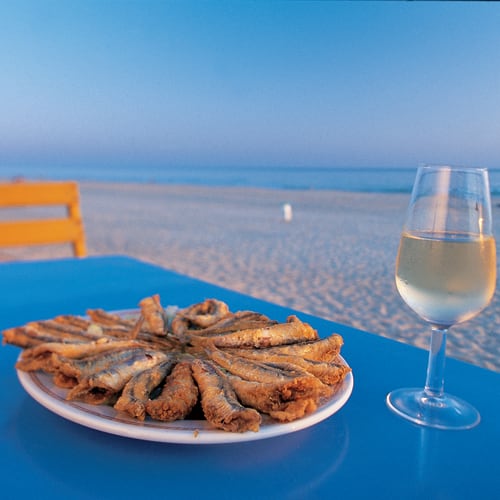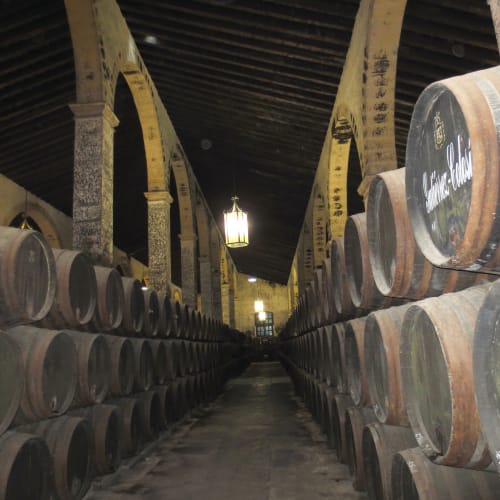Sherry - The Great Wine of Andalucia
January 2004




On a recent visit to Sanlucar de Barrameda we sat outside the bustling Casa Balbino, one of Spain's best tapas restaurants. Under the palms and orange trees, we feasted on amazingly fresh seafood - acedias, boquerones fritos and tortillitas de camerones, fried in the style of Andalucía. And to drink, we enjoyed one of the great wines of the world, Manzanilla sherry. Crisp, dry and refreshing, it is the perfect partner for fresh seafood and tapas. The ancient bodegas where Manzanilla is made are only blocks away, with their windows open to the sea breezes of the Atlantic that lend the wine its briny freshness.
Sherry is a misunderstood masterpiece. Really a family of wines, each type takes years to produce under the watchful eyes of winemasters who have learned the secrets of sherry from their fathers and grandfathers before them. They can only be produced in a triangle between the towns of Sanlúcar de Barrameda, El Puerto de Santa María and Jerez (from which the name 'sherry' comes), and almost all of the grapes are grown in the area between these ancient cities.

Unfortunately in the last several decades, some unscrupulous producers began flooding the market with cheap, sweet sherry. Sherry has been unfairly labeled as a cloying, sweet wine enjoyed by grannies and perhaps as a cooking wine used only rarely. The reality is far different, a dynamic collection of complex wines that can be enjoyed with a meal or savored by themselves. Over the last decade, wine critics of all stripes have been calling attention to this hidden jewel of the wine world.
The secret is in the aging process, called "criadera and solera." Fresh white wine from palomino grapes is kept in huge oak barrels stacked three high. The wine is fortified with a small amount of wine spirits to keep it from turning to vinegar, and as it ages a layer of yeast separates the wine from the air and protects it from oxidation. Over years, part of the younger wine is transferred to the barrels below, mixing with the more mature wine from previous years. Finally the finished wine is bottled from the bottom, oldest mixture. These barrels are stored in massive stone bodegas that keep the temperature and humidity at ideal conditions.
The result is called 'Fino' (or 'Manzanilla' in Sanlúcar) and is a clear white wine that is bone-dry. It is served well chilled and is easily the most refreshing wine we have ever tried. Spaniards usually serve this with olives, fresh seafood or as a palate cleanser before a meal.
'Amontillado' is the big brother of Fino, still quite dry but with a warm tan color and a hint of caramel flavor. To achieve this more complex, nuanced wine, Fino is reintroduced to the solera aging process, but is allowed to be in contact with oxygen from the air. This oxidation and another year of aging in ancient barrels create a delightful wine that can be enjoyed with almonds, cheeses or dried fruit.
'Oloroso' is a darker, smoother sherry with a nutty, caramel flavor. This complex wine is aged in contact with the air from the start, and can be aged for years or even decades. It is usually served with roasted meats or fine cheeses.

And finally come the sweet sherries, the finest of which bear very little resemblance to the cheap varieties which have caused so much damage to sherry's reputation. Pedro Ximénez is made from grapes of that name which are dried in the sun before being pressed. Legend has it that Pedro Ximénez was introduced to Spain from Germany by a soldier called Pedro Ximénez (or Peter Siemens - Pedro Ximen). It is also aged in the solera process. This dark, intense sherry is usually served after a good meal, its sweet raisiny flavor providing the perfect finish.
Moscatel is the other great sweet sherry. From bright green grapes with a higher sugar content, it is a silky smooth white wine with flavors of melon and orange blossom. It is perfect as an accompaniment to fruit or dessert.
Finally there is the category of cream sherries, which are simply a mix of Oloroso or Amontillado with one of the sweet sherries. The people of the sherry region will often make their own mixes at home, blending their favorite dry sherry with a small amount of sweet Moscatel or Pedro Ximenez.
Of course, as with any wine, the true measure of a sherry's quality depends on the bodega. And we are pleased to see the traditions of sherry developing. For decades the big bodegas with the powerful brands would buy sherry wholesale and blend them under their own labels. Recently some small bodegas have started changing the focus. Our friends Juan Carlos and Carmen Colosia of Bodegas Colosia in El Puerto recognized years ago that the future of sherry is in top quality, small production wines supervised by their family. Their small bodega, built in 1838, sits on the Guadalete river, looking over the bay of Cádiz. Here they carefully manage the criadera and solera process to create wines that are recognized as among the best sherries in the world.
The best sherry is created by a caring winemaster, who buys the best young wine, and using skills passed down over generations, forms it into a complex and special sherry. The location of the bodega and the quality of the casks are very important, but it is the people who shepherd this wine that make the difference between a good and a great sherry.
Surprisingly, given the complex and costly aging process, most good sherry sells for less than $20 a bottle, though a long aged top quality sherry can command prices well over $100. We encourage you to introduce your palate to one of these great wines. Versatile, complex and full of surprises, you may find a new favorite in the sherries of Spain.

